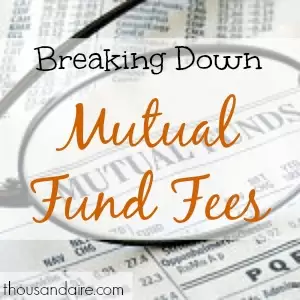Mutual fund investors love to complain about fees. None of us wants to see our returns reduced by expenses, in any market. When our investments are down, it seems like insult to injury. And when they’re up? Our investment has grown, which means that we actually pay more than we would if it hadn’t.
A word of advice: it doesn’t pay to think about it too much. I’m not saying that comparing expense ratios isn’t absolutely necessary for making responsible investment decisions. But I’ll be honest – I have never in my life converted that ratio into actual dollars for any of my mutual fund investments. Why? Because I don’t need to, and because looking at actual dollars going out of my account will probably drive me crazy.
That being said, you won’t find me ranting about fees. My investments are available to me because someone created them and put them on the market – expecting to take advantage of them without paying for it isn’t reasonable or ethical. Just like any other product, however, some operate more efficiently than others, and thus cost less. Index funds tend to be cheaper, for example, in part because the time and effort it takes to run them is less than for an actively managed fund.

I stand by my advice not to dwell on it. But I also find that it helps to know where your money is going. Here is a rundown of the types of fees charged by mutual funds, though not all funds charge all of these fees:
Sales charges, or loads. These can apply at the time of purchase or at redemption, and they are used to pay commission to a broker. No-load funds, as the name implies, don’t have sales charges. But they may have any of the other fees on this list, including a purchase fee.
Purchase and redemption fees. These differ from sales loads only in that the fee is paid to the fund, rather than a broker.
Exchange fee. May apply when a shareholder switches funds within the same fund family.
Account fee. Accounts below a certain amount are purported to cost the fund company more money than they earn in fees, and as such may be subject to an account fee. (I say “are purported” not necessarily because I don’t believe it, but simply because I’ve never seen the math.)
Management fees. These are paid to the fund’s investment advisor for managing the fund.
12b-1 Fees. Also called distribution fees, these relate to sales and marketing activities by the fund, and some shareholder services. Not all funds charge 12b-1s, so you want to pay attention to these.
Other expenses. You knew it was coming – that miscellaneous category of expenses.
Check your prospectus, and a final word of advice.
All of this information is available as a table in a mutual fund’s prospectus. If you have never read a mutual fund prospectus, I recommend you give it more than a passing glance. For starters, prospectuses have a general order to them, so once you get the hang of one, you’ll be able to easily peruse another for the information you deem relevant. Additionally, prospectuses contain information you won’t find in a quick web description or analyst’s report. Be advised, however, that it is an excruciatingly boring read, even for me. If you aren’t the prospectus-reading type, and even if you are, there are a number of calculators available on the web for comparing fees between mutual funds.
As with most things we purchase, cost is an important consideration, but not the only one. Choosing a fund by expense ratio alone makes about as much sense as buying a house based on price and nothing else. You can pat yourself on the back that you paid a low price, but you may not much like where you’re living.

